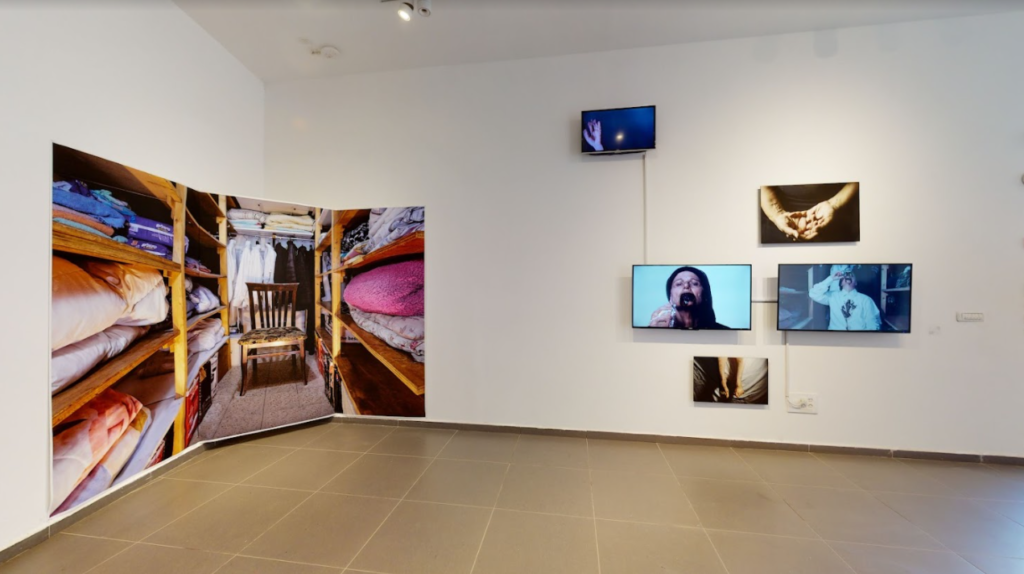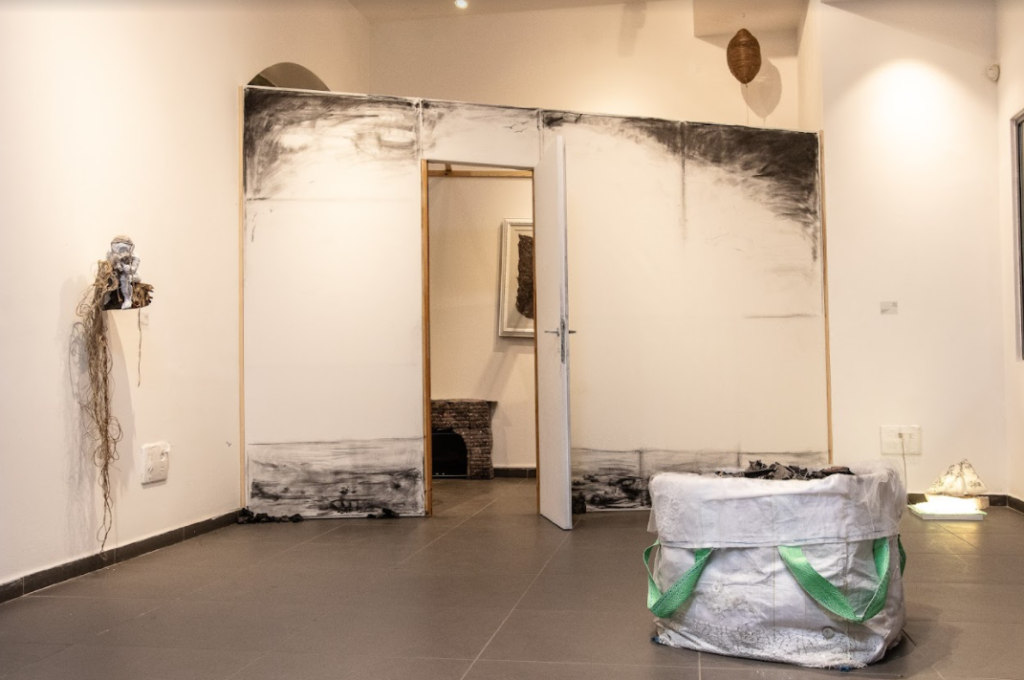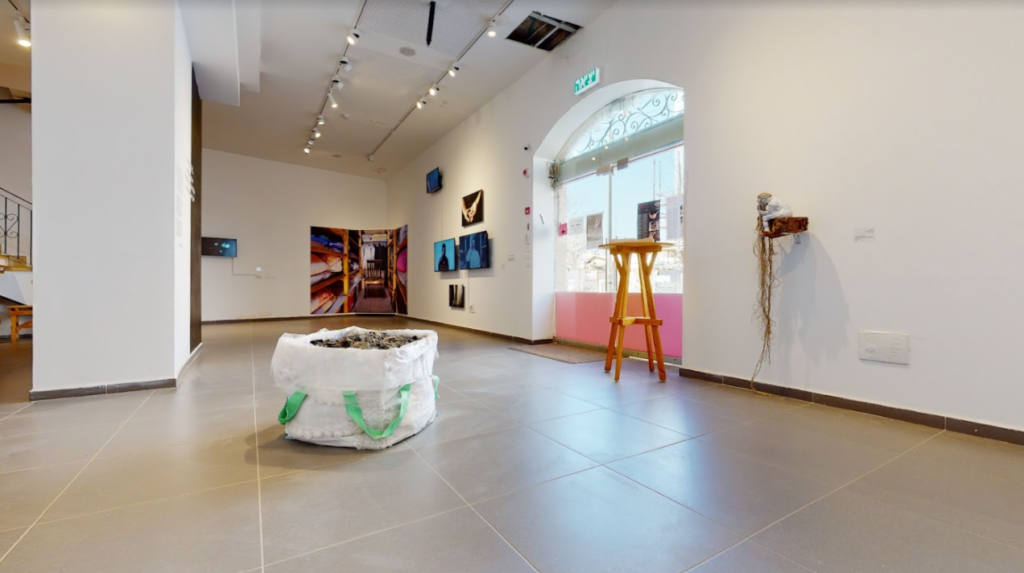תערוכה ירח לבן קפה שחור מתפקדת כשתי תערוכות יחיד שיש בניהן נקודות השקה. יהודית ברמץ ואלינורה שוורץ הן יוצרות שונות במבען האמנותי, בהשקפותיהן ובחיפוש שלהן, אך העבודות של שתיהן נוצרות כשהלילה יורד, בזמן השקט שבו זכרונות אישיים או כאלה שהורישו להן קרובות משפחה מדורות קודמים, צפים ועולים אל התודעה. הזמן החשוך, שחור כקפה, הוא זמנם של אגדות וסיפורים לפני השינה, הרהורים וחלומות, וזמנם של תשומת הלב לגוף, תשוקותיו, זכרונותיו וכאביו. ברגעי השקט הליליים, בהם העולם נדמה ריק והאדם חש בודד אך גם מחובר אל מציאות קוסמית, מתגלה לעיתים אור הירח המסמל תקווה בהירה לאחוז בה.
ירח לבן
יהודית ברמץ מתייחסת לארבעה סיפורי ילדות, כל אחד מהם מסמל עבורה תקופה ושלב בחיים.
בכל הסיפורים הללו, במקביל למציאות תמימה, יש צל שאורב ומאיים ודמות סמלית: ירח, איש זקן וסירה, שתפקידה להאיר ולהרחיק את הפחד. יש בסיפורים הצצה ליחסים עם מבוגרים שונים, ובמיוחד עם אב ואם, והם נושאים משהו מכובד משקלם של זכרונות משפחתיים כואבים שעברו בין הדורות עד שמצאו את קולם ומקומם באמנות של ברמץ.
ארבעת הסיפורים מסמלים את המעבר מילדה, לנערה ולאישה. בחלקם מופיע פגם בסיפור המקורי המתגלה רק מנקודת המבט הבוגרת, אך כולם הופכים בחכמה ובעדינות גם לסיפור המספר את ההווה המורכב. ההיבט התהליכי והתרפויטי נוכח בעבודות ומוביל את הצופה בהדרגה לגילויים חדשים.
GoodnIght Moon הוא סיפור לפעוטות בו נפרדים בהדרגה בברכת "לילה טוב" מהחפצים השונים שבחדר, בית בובות, מסרק, מנורה, כסא נדנדה, שעון, בלון אדום, אח בוערת ועוד. ברמץ יוצרת מיצב שמתחקה אחר החדר מהסיפור, ומאפיינים אותו ניגודים בין זיכרון לשכחה, בין חיים ומוות, בין חושך לאור ובין הבטחה לאכזבה.
המיצב שמתייחס לספר המאויר, בנוי כמעין רישום בתלת מימד, בפרספקטיבה אלכסונית ואקצרה ציורית שמותאמת גם לנקודת המבט של המציצים פנימה מחלונות הרחוב וגם לאלה המביטים בו מתוך הגלריה.
בתוך החדר מוצבים אובייקטים שמתייחסים לחלק מהחפצים שבסיפור המקורי. החפצים עשויים אבק בית ופסולת טקסטיל ממייבש הכביסה. חומרים נפסדים, ביתיים, מעט דוחים, שחושפים בעצם חומריותם את העמלנות והסיזיפיות שבניהול בית ובתהליך אמנותי, את שטף החיים מול הזמן החולף.
האובייקטים משמרים משהו מחווית הפליאה וההיקסמות הילדית: האור בוקע מבית הבובות, השעון מתקתק, עבודת הוידאו מתנגנת, והכסא מזמין לשבת ולהתנדנד בנחת. אך לצד ההבטחה שבאלה, החומר האפרורי והעמום שממנו יצרה את האובייקטים מעורר אי נוחות.
על הקיר תלויה תמונה, ובה ירח נטול זוהר ושלושה כסאות ריקים. שלושת הדובונים שישבו עליהם בסיפור המקורי נעדרים מהחדר, והכסאות הריקים משדרים תחושת עיזבון, כך שנדמה שמדובר ברוח רפאים של חדר שרק בחלקים קטנים ממנו עוד פועמת חיות.
באח מוצגת עבודת הוידאו "בעירה" שמתעדת את האמנית ואמה היוצאות יחד לטבע, כפי שהיו יוצאות בעבר לצייר יחד, אך הפעם הן יוצאות לשרוף ציורים ורישומים של ברמץ מימי לימודיה במכון פראט בניו יורק. העבודות נקרעות ואז עולות באש אט אט, הדימויים נהרסים, משחירים ונותר מהם רק פחם.
בין הקנבס הלבן והמתוח ממנו עשויים קירות החדר, לבין הציורים שעולים באש ללא הסבר מדוע, מסמנת האמנית מסלול מעגלי בין יצירה לאיקונוקלזם, בין בחירה מלאת אמונה בכוחה של יצירה אמנותית לבין הרצון למחוק את העבר על האמנות שהתקיימה בו עד כי יהפוך לפחם.
אך זה אינו סוף הסיפור שהרי הפחם הוא חומר שניתן לצייר בו רישומים חדשים, וליצור ממנו מיצבים חדשים.
חנהל'ה ושמלת השבת, הוא אמנם סיפור ילדים ישראלי ידוע, אך ברמץ התוודעה אליו כאישה בוגרת שעוסקת בתרפיה באמנות ובטיפול תהליכי בפוסט טראומה. "השמלה" - על רצפת הגלריה מונח שק מלא פחם, מצופה בשכבות של מלמלות, תחרות, בדי שיפון רכים, פרחים, פייטים ופנינים, כולם בלבן וכסף. זוהי הכלאה מפתיעה בין שק העשוי שתי וערב של סיבי פלסטיק פשוטים שבדרך כלל מצוי באתרי בניה- טריטוריה גברית מובהקת, לבין שמלת כלה רכה, מפורקת, ועוטפת. הבדים העדינים מאיימים להתלכלך מהפחם השחור וחושפים נקודת מבט מפוכחת, כזו שאינה רואה בסיפור רק תום וקסם אלא רמז לסכנה האורבת במפגש עם גבר שעלול להכתים אותה. אחרי שהתלכלכה משק הפחמים, יושבת הילדה בודדה ובוכה, הירח הלבן מתגלה ומאיר אליה, מלבין ומזהיר את שמלתה, והיא עוברת תהליך סימבולי של התבגרות, ריפוי וטהרה.
כשהייתה סטודנטית צעירה, ברמץ נהגה לספר סיפור דמיוני בהמשכים לאחייניותיה, הדמות שהובילה את הסיפור היא דמותו של איש זקן בעל זקן ארוך ארוך, זהו ארכיטיפ יונגיאני למורה דרך חכם שמוביל את את האדם לידע קדום.
נגד הרוח- פסל העשוי זכוכית, מראה, גבס ומתכת נוצר בהשראת סיפור אישי של אביה, שכשהיה אדם צעיר שהה בתקופת משבר בכרתים, הוא חווה חזיון כשראה סירה קטנה נלחמת במים הסוערים ומצליחה לשוט, הרגע שסיפר את הסיפור לביתו השפיע עליה והפך לרגע מכונן, עד כי חשה שהפך לסיפור שלה. הפסלון מתיך יחד חומרים שונים ומחזיר אור דמוי-ירח על תקרת הגלריה.
התהליך המתמשך של יצירת הפסלים, וההצבה בחלל, הופכים את האמנית ממאזינה פאסיבית לסיפור למי שבוחרת לספר אותו מחדש תוך שהיא מובילה את עצמה ואת הצופה לפרקים חדשים.
קפה שחור
אלינורה שוורץ חיה חיים כפולים. חייה כאם חרדית במשפחה חסידית בקהילה דוברת יידיש, ובמקביל חייה המוסתרים כאמנית, בוגרת המחלקה לצילום במוסררה ובוגרת האקדמיה למחול. כאמנית היא עוסקת בסוגיות טעונות ואישיות, ובשפה ישירה וחשופה שנולדת מהקשרים שבין מיניות, הסתרה, פגיעוּת ויצריות.
שוורץ יוצרת בארון, ליתר דיוק בחדר הארונות. שם, בין החולצות הלבנות של בעלה לבין ארגזי הפפסי לשבת, היא מצלמת, בחשש מסויים, עבודות וידאו וחוקרת מחוות גופניות שונות.
בתערוכה שוורץ אינה יוצאת מהארון שבביתה אלא מוציאה אותו ופורשת אותו בפנינו בחלל הגלריה בקנה מידה של כמעט 1:1. כמו הופכת אותנו לשותף סודי הנכנס איתה לתא וידויים אינטימי, צר. האמנות נוצרת אמנם בפרטיות ובחושך שבארון אך בתערוכה היא מאירה את המקום, מפנה בו מקום למבט אחר וחדש, אך בכך אולי גם מחללת אותו.
חילול ופגיעה, בין אם במערכות יחסים שונות בין נשים לגברים ואם בין אשה לעצמה, שבים בעבודות השונות שמוצגות בתערוכה. שוורץ מחפשת אחר פתחי אוורור במציאות לופתת, שמורכבת מחוויות שעברה בעצמה ומחוויות שספגה מסיפורי משפחה קשים ששמעה בילדותה.
הקולאז' הוא כלי של חיתוך, קריעה, חשיפה חלקית, הדבקה וחיבור, ככזה הוא מאפשר לשוורץ לגעת במגוון הקשרים, חוויות ואסוסיאציות בלי לחשוף את התמונה המלאה. אך במבט בקולאז'ים של שוורץ, בדימויים המצולמים המכילים שכבות שונות, בשילוב בין סטילס לוידאו, ובחיבורים בין הנשי לגברי ובין הנסתר לגלוי, מתברר כי תחושת ההדבקה והחיבור אינן מרכיבות שלם אחד.
המיצב "תרתי משמע" מכיל מקבץ עבודות וידאו וצילום שבכל אחת מהן מופיע איבר במנח שונה, תלתל מסתלסל על אצבע, כפות רגליים צפות, ראש. הרקע של האמנית שהייתה בעברה רקדנית ושחקנית מוביל אותה לחלץ דימויים מתוך הגוף המסרב למישטור ומביע את מחאתו בד' האמות של החדר הפרטי. הדימויים מאופיינים בנזילות מגדרית שנוכחת כאן גם בשל האמביוולנטיות ביחס לחוויית הקיום הבסיסית כאישה, וגם בשל ההקשר הדתי שמחיל הגבלות על חשיפת גוף אישה.
המיצב כולל גם את צמד עבודות הוידאו שהעניקו לתערוכה את כותרתה, באחת, שוורץ לבושה בחלוק בית טיפוסי, ובשנייה, בחולצת גבר לבנה ומכופתרת. בשתיהן היא אוחזת בידה כוס קפה שחור, משקה שמזוהה עם גבריות, עמל ומזרחיות. היא מביטה בריכוז למצלמה או לצופה, מרימה את כוס הקפה שבידה, ומקרבת אותה לפיה, לוגמת באיטיות מן הקפה אך אינה פוסקת, הקפה השחור מתחיל להישפך בזרזיף דק ועיקש ולהכתים את גופה ובגדיה, ובצופה מתחיל להתעורר צחוק, גועל או תחושת אימה. למרות הרטיבות והלכלוך היא אינה פוסקת מלשתות, כאילו היא כפויה לשתות אותו עד תום. לבסוף היא מורידה את כוס הקפה, שצייר זקן שחור על סנטרה, פיה מלא בבוץ השחור שנשאר תמיד בתחתית הספל. האקט היומיומי והשלו של שתיית קפה הופך למופע מסויט של אילמות ואלימות. הרגע הדק שבין האמנית השותה קפה שחור לבין הרגע בו היא הופכת לדמות שפניה מושחתות, פיה חסום, ונדמה כאילו היא נקברת בחיים, משמש כמטאפורה למתח הקיים בחייה.
לצד המחנק, הכאב, הזעם הכבוש וההתרסה שעולה מן העבודות השונות, מרשה לעצמה שוורץ לחלום מציאות אחרת שמגיחה אל תוך המרחב הכאוב ומוסיפה בו אור, אוויר וצבע, ומתגלה בשתי עבודות וידאו:
באחת. וידאו כמעט מופשט המתאר זהרורי אור שנכנסים מבעד לחלון המסורג. הלך רוח ילדי, מלא פליאה והבטחה, שמוצא אור גם בחדר חשוך, ומהדהד את הירח לבן בעבודות של יהודית ברמץ שניצבות ממול.
ובשנייה, האמנית, מצולמת מגבה, צועדת משוחררת, ללא יעד ברור, באחו ירוק ושקט. הזרימה שבתנועה, העשבייה והמהירות שמזכירות גם מבט של בעל חיים, הצבעוניות החריגה למול גוף העבודות המונוכרומטי, נדמות כפותחות חלון אל מציאות חדשה שנמצאת בהישג יד.




